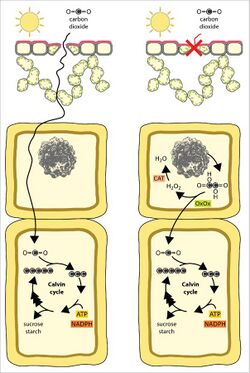Biology:Alarm photosynthesis
Alarm photosynthesis is a variation of photosynthesis where calcium oxalate crystals function as dynamic carbon pools, supplying carbon dioxide (CO2) to photosynthetic cells when stomata are partially or totally closed.[1] This biochemical appendance of the photosynthetic machinery is a means to alleviate the perpetual plant dilemma of using atmospheric CO2 for photosynthesis and losing water vapor, or saving water and reducing photosynthesis. The function of alarm photosynthesis seems to be rather auxiliary to the overall photosynthetic performance. It supports a low photosynthetic rate, aiming at the maintenance and photoprotection of the photosynthetic apparatus rather than a substantial carbon gain.[2]
History
The alarm photosynthesis process was first evidenced in pigweed Amaranthus hybridus plant in 2016 when A. hybridus leaves were exposed to drought conditions or exogenous application of abscisic acid. The same study showed similar results in Dianthus chinensis, Pelargonium peltatum, and Portulacaria afra plants under drought stress.[1] In 2018, the alarm photosynthesis process was exhibited in A. hybridus plants under controlled CO2 starvation conditions.[2] In 2020, evidence of this process was shown in the Antarctic extremophile plant Colobanthus quitensis under CO2 limiting conditions.[3]
Mechanism
Under stress conditions (e.g. water deficit) oxalate released from calcium oxalate crystals is converted to CO2 by an oxalate oxidase enzyme and the produced CO2 can support the Calvin cycle reactions. Reactive hydrogen peroxide (H2O2), the byproduct of oxalate oxidase reaction, can be neutralized by catalase.[4]
Differences against CAM and C4
Alarm photosynthesis represents an unknown photosynthetic variation to be added to the already known C4 and CAM pathways. However, alarm photosynthesis, in contrast to these pathways, operates as a biochemical pump that collects carbon from the organ interior (or from the soil) and not from the atmosphere.
See also
References
- ↑ 1.0 1.1 Tooulakou, Georgia; Giannopoulos, Andreas; Nikolopoulos, Dimosthenis; Bresta, Panagiota; Dotsika, Elissavet; Orkoula, Malvina G.; Kontoyannis, Christos G.; Fasseas, Costas et al. (2016-08-01). "Alarm Photosynthesis: Calcium Oxalate Crystals as an Internal CO2 Source in Plants" (in en). Plant Physiology 171 (4): 2577–2585. doi:10.1104/pp.16.00111. ISSN 0032-0889. PMID 27261065. PMC 4972262. http://www.plantphysiol.org/content/171/4/2577. Retrieved 2020-10-17.
- ↑ 2.0 2.1 Tooulakou, Georgia; Nikolopoulos, Dimosthenis; Dotsika, Elissavet; Orkoula, Malvina G.; Kontoyannis, Christos G.; Liakopoulos, Georgios; Klapa, Maria I.; Karabourniotis, George (2019). "Changes in size and composition of pigweed (Amaranthus hybridus L.) calcium oxalate crystals under CO2 starvation conditions" (in en). Physiologia Plantarum 166 (3): 862–872. doi:10.1111/ppl.12843. ISSN 1399-3054. PMID 30238994. https://onlinelibrary.wiley.com/doi/abs/10.1111/ppl.12843. Retrieved 2020-10-17.
- ↑ Gómez-Espinoza, Olman; González-Ramírez, Daniel; Bresta, Panagiota; Karabourniotis, George; Bravo, León A. (October 2020). "Decomposition of Calcium Oxalate Crystals in Colobanthus quitensis under CO2 Limiting Conditions" (in en). Plants 9 (10): 1307. doi:10.3390/plants9101307. PMID 33023238.
- ↑ Tooulakou, Georgia; Giannopoulos, Andreas; Nikolopoulos, Dimosthenis; Bresta, Panagiota; Dotsika, Elissavet; Orkoula, Malvina G.; Kontoyannis, Christos G.; Fasseas, Costas et al. (2016-09-01). "Reevaluation of the plant "gemstones": Calcium oxalate crystals sustain photosynthesis under drought conditions" (in en). Plant Signaling & Behavior 11 (9): e1215793. doi:10.1080/15592324.2016.1215793. ISSN 1559-2324. PMID 27471886.
 |


